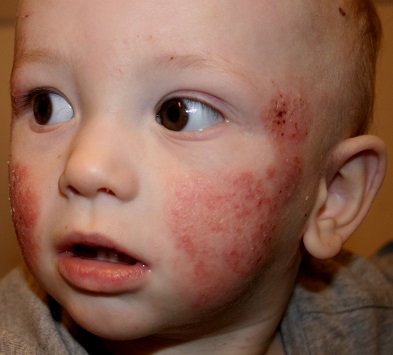 Dandruff, seborrheic psoriasis and seborrheic eczema are all the different terms that are used to denote seborrheic dermatitis. This condition is also known as cradle cap if occurs in infants. In this condition, the scalp skin is usually affected. Although it does not affect your overall health but it causes discomfort and sometimes embarrassment. It is not contagious nor a sign of poor hygiene. Seborrheic dermatitis is a chronic condition and affects people of all age. With a fairly high rate of recurrence, this condition is treatable but not curable.
Dandruff, seborrheic psoriasis and seborrheic eczema are all the different terms that are used to denote seborrheic dermatitis. This condition is also known as cradle cap if occurs in infants. In this condition, the scalp skin is usually affected. Although it does not affect your overall health but it causes discomfort and sometimes embarrassment. It is not contagious nor a sign of poor hygiene. Seborrheic dermatitis is a chronic condition and affects people of all age. With a fairly high rate of recurrence, this condition is treatable but not curable.
Symptoms of Seborrheic Dermatitis
Seborrheic Dermatitis is easy to identify because some of its characteristic symptoms. If you are showing any of these symptoms, you must contact to health care practitioner for proper diagnosis.
- Appearance of dandruff or skin flakes on the scalp such as hair, eyebrow, mustache, beard.
- Flaky white or yellow scales covered with grease patches or crust on scalp, chest, face, scrotum or other body parts.
- Redness on skin
- Redness on eyelids
- Itching, irritation or stinging.
Seborrheic Dermatitis Treatment
At most of the times, seborrheic dermatitis resolves spontaneously without any treatment. However, for some cases, it is necessary to seek doctor's advice on seborrheic dermatitis treatment.
Seborrheic Dermatitis Treatment for Infants
In case of infants, mild baby shampoo can be applied over the scalp, then rinse with warm water. If this does not help, then contact your doctor for more appropriate medicated shampoo for the dandruff shampoos may irritate your baby’s scalp. You can also apply mineral oil to soften the thick patches of the sebum and brush very gently so as to peel the scales off.
Seborrheic Dermatitis Treatment for Adults
- Apply Topical Lotions: If the dandruff problem spreads on other body parts then steroid lotion or cortisone should be applied on the scalp at least twice a day.
- Increase Sunlight Exposure: Proper exposure to sunlight inhibits the growth of yeast, it is recommended to do outdoor activities in order to help the rash go away.
- Take Fish Oil Supplements: Fish oil supplements, containing generous amounts of omega 3 fatty acids can help in reducing seborrheic dermatitis.
- Use Aloe Vera Cream: It reduces irritation and itching. Aloe cream is recommended twice a day for four to six weeks.
- Eat Antifungal Foods: Foods that are antifungal in nature such as ginger, oregano, radish, coconut oil, olive oil, sage and turmericin hibits the growth of yeast and fungus on the surface, so they prevent the disease naturally.
- Try Tea Tree Oil: One of the most effective treatments is the application of tea tree oil on the scalp. But tea tree oil may cause irritation or burning sensation so prior to application diluting and mixing it with aloe vera is recommended. For preparing the mixture put 20-25 drops of tea tree in the aloe vera gel. Apply this mixture on the scalp, leave for half an hour and rinse it off to remove dandruff.
- Massage: Massage in a circular motion that will help in improving the blood circulation. Mix olive oil and coconut oil or mix small amount of hydrogen peroxide with two tablespoons of apple cider vinegar and massage it gently over the scalp, then rinse it off with shampoo and warm water.
- Apply Apple Fenugreek Seeds Mixture: Soak about two tablespoons of fenugreek seeds in water for six hours, grind these soaked seeds to make a paste and add two tablespoon of lemon juice. Mix well, apply this paste over the scalp and leave for half an hour. For removing rinse it off with lukewarm water.
- Use Neem Leaves: Boil a few Neem leaves with water then cool it. Rinse your hair with this solution after every regular hair-wash.
- Try Anti-Dandruff Shampoo: Anti dandruff shampoos are considered as an obvious treatment for seborrheic dermatitis. Most of the anti-dandruff shampoos contains salicylic acid that possess anti-fungal and keratolytic property which helps in the removal of thick scale from the scalp. They also inhibit the growth of fungi and yeast on the skin surface.
- Use Shampoos with Coal Tar: These shampoos are prescribed in extreme conditions. These shampoos must be treated as medicines and should not be used as regular shampoos. After applying the shampoo, leave it for a maximum of five minutes.
Note: If the scale is dense and widespread, it must be softened first by applying mineral oil or olive oil then washing it several hours later with a detergent.
To learn an additional home remedy for seborrheic dermatitis management, please refer to this video:
When to Call a Doctor
See your doctor if:
- Your condition affects your sleep or distracts you from your daily routine;
- You feel anxious and embarrassed;
- You are suspicious of getting skin infection;
- You have tried some self-care steps and get no success.
Sometimes seborrheic dermatitis becomes so irritating that your daily life activities are getting disturbed, but from all the above information, we know that seborrheic dermatitis is a common and treatable condition. In many case home remedies will do the trick; however, if your condition is really severe, immediately contact to your health care practitioner or dermatologist.